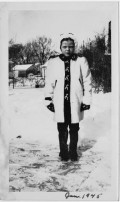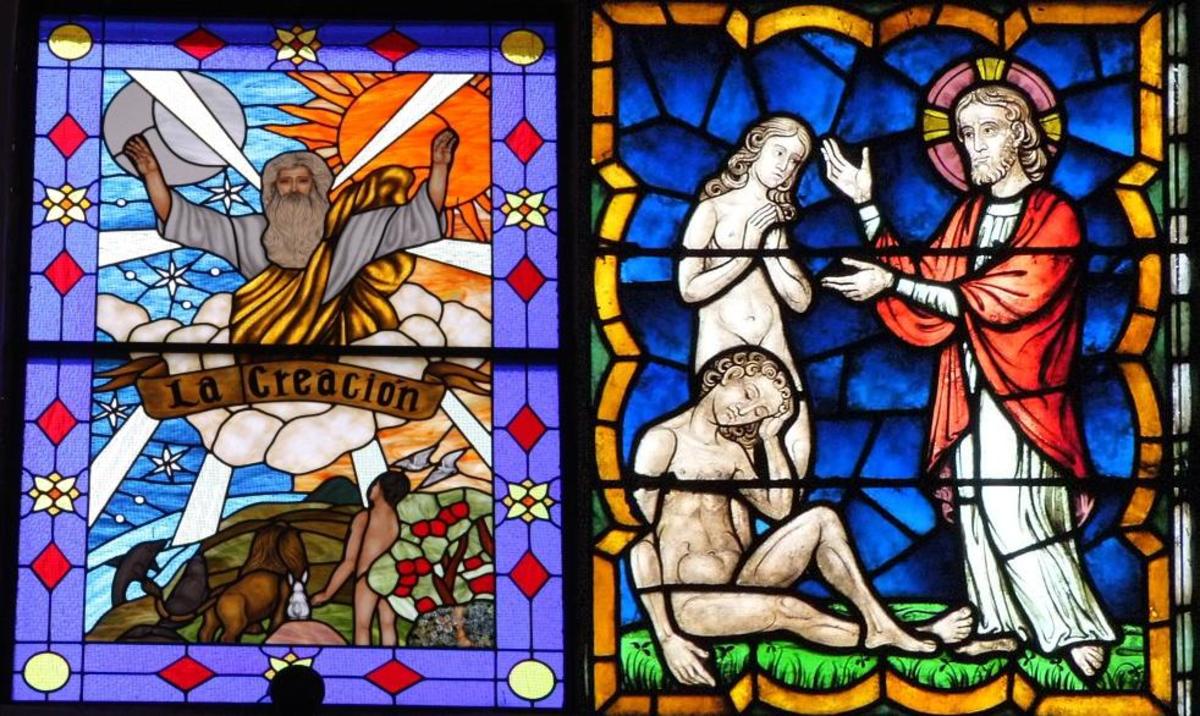Religion and Psychology
Sister John of the Cross, the main character of Mark Salzman's novel Lying Awake, offers a very interesting case study in the psychology of religion. I find that in studying this character, no single perspective fully fits Sister John's experience. We can seemingly explain her experiences using different positions, and I will consider some. However, when looked at as a whole, Sister John's faith remains as elusive as the God she is seeking.
The easiest aspect of Sister John's religious life to deal with is her mystical experiences. Often preceded by an intense migraine, Sister John occasionally has a vision. Sister John also perceives her world with a new awareness of the presence of God. Under the profound influence of these experiences, she has written a best-selling book of poetry, and her writing output expands prodigiously. Because her religious life had previously been very dry for her, Sister John rejoices in these experiences.
Sister John's newfound intimacy with God lasts three years. Her doctor originally treated her headaches as migraines, but after a particularly powerful episode, subsequent tests reveal she has a lesion in the temporal lobe of her brain. Another doctor diagnoses her with a treatable form of temporal lobe epilepsy. This problem caused both her headaches and her mystical experiences. If she were not a cloistered nun, she may have been diagnosed sooner. In an intensely religious environment, her Sisters thought God had given her a special gift of grace.
David M. Wulff described some effects of temporal lobe epilepsy. The most common features associated with this disorder include intense interest in religious or philosophical issues, compulsive writing, altered sexual patterns, and more aggressive behavior.1 Sister John easily exhibits the first two symptoms. As a cloistered celibate, her sexual activity is nonexistent, and saying whether her sexual activity would have been altered otherwise is impossible. Only the last symptom does not fit Sister John's case. She does not seem any more aggressive than before the onset of her symptoms. If anything, she was euphoric.
However, her symptoms are similar to a case study described by Wulff. Here, temporal lobe epilepsy altered the patient's behavior in some unusual ways. The patient began sunbathing nude, reported being sexually aroused at Mass, and had experiences she described as "sexual union with God." She also started writing extensively about her preoccupations, and was in a state of constant euphoria. Additionally, the patient was subject to violent headaches accompanied by vacant staring.2 Again, the sexual characteristics do not fit Sister John's case, but the other elements fit well.
Dismissing Sister John's mystical experiences as a by-product of her temporal lobe epilepsy would be easy. Before she began experiencing her headaches, her life of faith was dry, even dull. Though she very much wanted to experience a feeling of intimacy with her God, it never happened. When surgeons removed the lesion, the mystical experiences ended. Case closed.
Or is it? For Sister John, the experience of being so close to God was an answer to prayer. She had essentially despaired of finding the things she was looking for in the convent, contenting herself with moving with the rhythms of the order. We might ask a more basic question about the cause of her epilepsy. Is it merely a biological aberration, or might there be something else going on? That is a question that will not admit an easy answer.
Sister John's mystical experiences were in part shaped by her religious community. In looking at her religious experience, we should ask why she became a contemplative nun. In many ways, Sister John's calling resembles a religious conversion. Rambo and Farhadian give us an effective lens here. They describe a process, which they call stages of religious change, which I will use to try to understand Sister John's calling.3
Rambo and Farhadian assert that religious conversions take place within a contextual framework consisting of both large scale domains like political systems and smaller circumstances like home life.4 The novel assumes a basic macrocontext of American Catholic life in the city of Los Angeles. I will concentrate instead on the microcontext, i.e., the individual background Sister John comes from.
As a child, then known as Helen Nye, both her parents abandoned Sister John. Her father makes no appearances in the novel. Her mother left Helen to be with another man, eventually having two additional children. Her grandparents raised Helen. She received the occasional letter and phone call from her mother, but those contacts ended after the death of Helen's grandfather.
Helen's grandparents sent her to a local Catholic school. She eventually came under the influence of one Sister Priscilla. Sister Priscilla served almost as a surrogate mother for young Helen. The nun taught her many life lessons, and would eventually become a catalyst in Sister John's decision to become a nun herself. Sister Priscilla filled the role of the necessary person in what Rambo and Farhadian called the encounter stage.5 It was Sister Priscilla's example that convinced Helen to enter the religious life. "He's after you," Priscilla said (91). Shortly afterwards, Helen became a Discalced Carmelite postulant.
Sister Priscilla's overall influence alone was not enough. Rambo and Farhadian believe that a crisis is necessary to act as a catalyst for conversion. Either external or internal factors may cause the crisis, but they always challenge a person's view of the world. In response to the crisis, the person will search for ways to reorder their world. Rambo and Farhadian identify this as the quest stage.6
For Helen, the crisis and quest stages were intimately linked. Helen's crisis stage likely began with the death of her grandfather. Helen discovered the body. When Helen's mother missed the funeral, this created an irreparable breach between her grandmother and her mother. Helen could do little more than watch her grandmother age much more quickly. The young woman was clearly disoriented, and sought out Sister Priscilla for help. Driving to the chapel of her old school, she attended Mass. Something happened during the priest's homily, which Helen was not able to describe to Priscilla.
Whatever it was, it was crucial in reorienting Helen's life and eventually led to her new life as Sister John. That is, she entered the commitment stage.7 She decides to enter a convent, and spends the next several years interacting with other nuns, especially her novice mistress. She takes vows of obedience, poverty, and chastity. Sister Helen dresses differently, acts differently, and separates herself from the world. Eventually, she takes the religious name of Sister John of the Cross.
The final stage of Rambo and Farhadian's schema is the consequences stage. This is the time when the convert assimilates the new life of the faith community. Sister John transforms her whole life, learning to live with the duties her conversion entails. Rambo and Farhadian say that this process is ongoing.8 This is certainly the case with Sister John. Indeed, we can read Salzman's entire novel as Sister John's transformation process.
Sister John had been a Carmelite for twenty-five years before she started having mystical experiences. She experienced the time between her Solemn Profession and the beginning of her euphoric faith as a "period of spiritual aridity" (99). This raises an important question. Why did she stay at the convent? If we answer this question, we will have the glue that holds her religious experience together.
James Pratt gives us some insight here. He suggested a typology of four different kinds of belief. The first type is primitive credulity, in which the person essentially believes what adults tell him unless some reason for doubt arises. Intellectual belief relies on authoritative sources to counter doubt. Emotional or affective belief is the inner experience of the person that compels and drives his religious belief. Pratt's fourth type, volitional belief, is the most relevant for our case study.
Volitional belief begins in the will. Usually, the person is incapable of the affective belief that experiences the divine presence in everyday life. However, she wants to believe. So she develops her faith by consciously acting as if she did believe. She actively suppresses anything that might detract from that faith. Sometimes, volitional faith may develop into a more emotional type of faith. Usually, she settles into an unsophisticated trust which can be quite supportive.9
This may be exactly what Sister John did over the years. "She was a bride of Christ, but still had not met her Spouse, and the farther she traveled inward without finding Him, the more aware she became of His absence" (98). Sister John follows the rhythms of the convent--prayer, daily Mass, work, reflection. Nevertheless, she starts doubting her vocation.
Then her mother comes to visit. Instead of seeking reconciliation, she asked Sister John not to contact her again. Her mother had a new life now, and did not want any complications. Sister John suppressed the urge to retaliate and did her duty by forgiving her. Even then she did not feel any closer to God. After that, Sister John, feeling she was not getting anywhere, merely redoubles her efforts and throws herself into the everyday life of the convent.
Discovering she had epilepsy was a grave disappointment for Sister John. Religious orders routinely reject epileptics as candidates for the cloistered life. Epilepsy had a reputation for "producing compelling -- but false -- visions" (67). Deciding what to do about her disorder was an ordeal for her, and not surprisingly, she falls back upon the volitional faith she always had and probably did not recognize. She ultimately opts to have the lesion removed out of duty to her Sisters. "To give up her ecstasies for their sake would be, if not a spiritual decision, at least an honorable one" (142).
The surgery seemingly puts her back into her previous dry state, lacking the intimacy with God she thought she had found. Like her namesake, Sister John does manage to keep her faith when faced with her own dark night of the soul. She gets back into the convent life in time to be part of the ceremony initiating another person into the Order of Discalced Carmelites. She will continue to work and pray.
That is enough for Mother Emmanuel to choose Sister John to be the novice mistress for a new postulant. Mother Emmanuel believes Sister John has special insight on the difficulties faced in doing God's will. Sister John confesses that she has no knowledge of God's will. Mother Emmanuel's reply is insightful. "Yet you're still here, trying to do His will anyway. That's the kind of understanding I meant. The doing kind, not the knowing kind" (181).
Perhaps Sister John knows God better than she thinks.
------
1David M. Wulff, Psychology of Religion: Classic and Contemporary, 2nd ed., (New York: John Wiley & Sons, 1997), 100.
2Ibid.
3Lewis R. Rambo and Charles E. Farhadian, "Converting: States of Religious Change," in Religious Conversion: Contemporary Practices and Controversies. Ed. by Christopher Lamb and M. Darrol Bryant (London and New York: Cassell, 1999), 23-34.
4Rambo and Farhadian, 24-25.
5Rambo and Farhadian, 28-29.
6Rambo and Farhadian, 25-28.
7See Rambo and Farhadian, 31-32.
8Rambo and Farhadian, 32-33.
9Wulff, 510-512.









